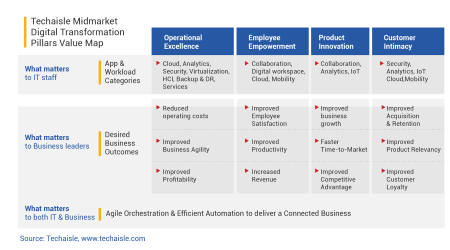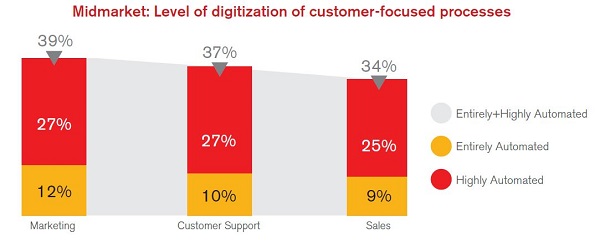IT trends belong to one of two main categories. Some, like Linux or cloud, refer to a product or product category that changes IT strategies by providing breakthrough capabilities. Others are statements of IT strategy, highlighting opportunities to directly connect IT capabilities to broader business objectives.
Digital transformation (DX) is an example of this second type of trend. DX, according to a report by global research leader Techaisle, is the integration of digitalized processes to achieve enterprise-wide automation spanning multiple functions; modernization of current processes and supporting infrastructure to achieve previously-unattainable or unimaginable business outcomes.
Digital transformation isn’t defined by a single initiative or end-point. DX describes an evolving set of capabilities that connect investments in core technologies to enhanced operational efficiency, employee empowerment, product innovation and customer intimacy – which in turn enable DX adopters to increase revenue, decrease costs, reach new markets, deliver better products and services, and ultimately, drive more profit and improve shareholder value.
Viewed from this outcome’s perspective, DX success is rooted in the ability to connect incremental investments in technology with milestone achievements, aligned within a roadmap that ties to the organizational vision of modern capabilities delivering new levels of business performance.
The channel will play a critical role in guiding midmarket firms through the DX transformation. This starts with helping IT and executives within client organizations to define their vision for the key competency areas: mapping the digital transformation pillars to business outcomes provides IT and non-IT management with a cohesive set of meaningful objectives for addressing business pain points.

Capturing the midmarket DX opportunity
What does the channel need to do to translate midmarket demand for DX and its attendant benefits into long-term customer relationships? To capitalize on the DX opportunity, channel partners need to develop deep understanding of how the DX platform is built – how this framework supports process evolution – and how to cleanly align the IT and process frameworks with a delivery plan that addresses midmarket executive care-abouts.
















